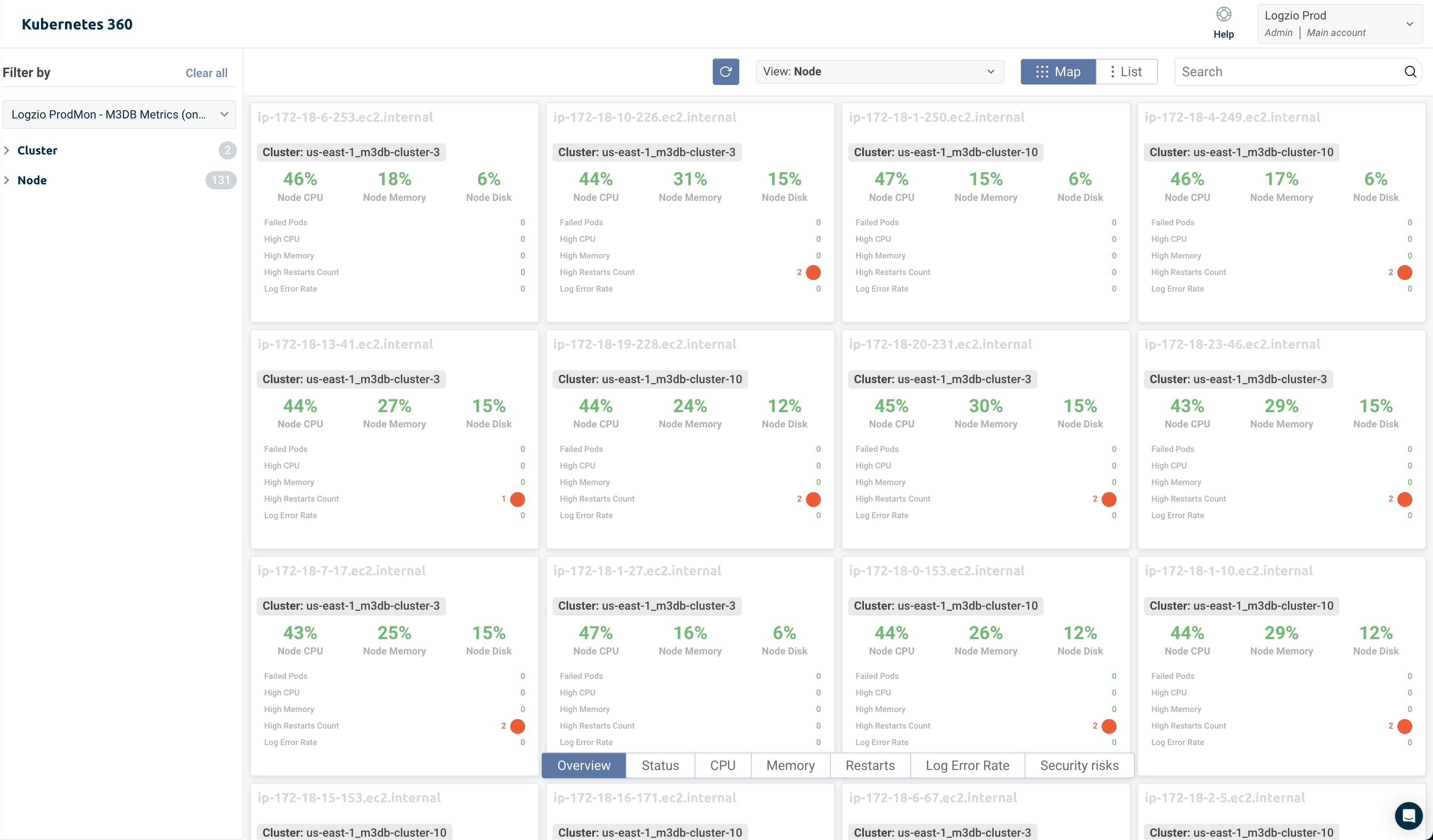Kubernetes 360 application provides an overview of your Kubernetes data, providing a quick overview of your current deployments, pods, and more useful information regarding your environment.

On this page
Manually shipping Kubernetes data
If you already have Kubernetes 360 data in your Logz.io account or prefer connecting Kubernetes manually, you’ll need an active Infrastructure Monitoring account, and ensure that your Kubernetes data is connected to Logz.io.
In addition, you’ll need to ship your cluster metrics from the following sources:
- Node exporter (should be installed on every node).
- CAdvisor.
- Kube-state-metrics version 2.1 or higher.
And send the following metrics:
| Metric name | Labels | |
| * | p8s_logzio_name // Equivalent to a Cluster's name |
|
| kube_pod_status_phase | pod, uid, node, host_ip, phase, namespace | |
| kube_pod_info | pod,namespace,p8s_logzio_name,region | |
| container_cpu_usage_seconds_total | pod, region, topology_kubernetes_io_region, container | |
| container_memory_working_set_bytes | pod, container, resource | |
| kube_pod_container_resource_limits | pod | |
| kube_pod_container_info | pod | |
| container_network_transmit_bytes_total | pod | |
| container_network_receive_bytes_total | pod | |
| kube_pod_created | pod | |
| kube_pod_owner | pod, owner_kind, owner_name | |
| kube_pod_container_status_restarts_total | pod | |
| kube_pod_status_reason | pod, reason | |
| kube_pod_container_status_waiting_reason | pod, reason | |
| node_cpu_seconds_total | instance, mode | |
| node_memory_MemAvailable_bytes | instance | |
| node_memory_MemTotal_bytes | instance | |
| kube_node_role | node,role | |
| kube_node_status_condition | node, status, condition | |
| kube_node_created | node | |
| node_filesystem_avail_bytes | instance | |
| node_filesystem_size_bytes | instance | |
| kube_node_status_allocatable | resource, resource | |
| kube_node_labels | logzio_p8s_name | |
| kube_replicaset_owner | owner_kind, owner_name,replicaset | |
| kube_deployment_created | deployment | |
| kube_deployment_status_condition | deployment,status | |
| kube_daemonset_labels | all labels | |
| kube_daemonset_status_number_ready | all labels | |
| kube_daemonset_status_number_available | all labels | |
| kube_daemonset_status_number_unavailable | all labels | |
| kube_daemonset_status_current_number_scheduled | all labels | |
| kube_daemonset_status_number_misscheduled | all labels | |
| kube_daemonset_status_desired_number_scheduled | all labels | |
| kube_job_labels | all labels | |
| kube_job_complete | all labels | |
| kube_job_status_failed | all labels | |
| kube_job_status_succeeded | all labels | |
| kube_job_complete | all labels | |
| kube_job_status_failed | all labels | |
| kube_job_status_completion_time | all labels | |
| kube_replicaset_labels | all labels | |
| kube_replicaset_spec_replicas | all labels | |
| kube_replicaset_status_replicas | all labels | |
| kube_replicaset_status_ready_replicas | all labels | |
| kube_statefulset_replicas | all labels | |
| kube_statefulset_status_replicas | all labels | |
| kube_statefulset_status_replicas_updated | all labels | |
| kube_statefulset_status_replicas_available | all labels | |
| kube_job_owner | all labels |
Manually configuring Security Risks
To add Security risks view to your existing Kubernetes data, you need to:
- Ship reports from Trivy operator.
- Configure and send security logs.
After setting up the Trivy operator, ensure your account receives type:trivy logs.
If you encounter an issue while setting up your metrics or logs, contact Logz.io’s support team for additional help.